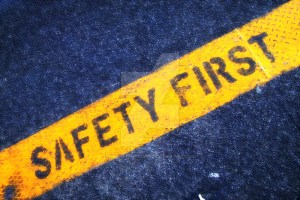
17 Apr Working Safely With Lead
Working Safely With Lead
 It used to be thought that only children were exposed to lead poisoning hazards which occurred mostly from eating lead based paint chips from doors or windows in the home. This is no longer the case. Studies conducted over the past few years now suggest many adults are exposed to lead in the work place and suffer from varying degrees of lead poisoning. These studies have also shown that eating lead based paint chips is not the only or even the primary way for lead to enter the body. Workers that use lead based paints, or work with items that may contain small amounts of lead may be creating lead dust and lead fumes that settle on their clothing, furniture, carpets, drapes and contaminate the air.
It used to be thought that only children were exposed to lead poisoning hazards which occurred mostly from eating lead based paint chips from doors or windows in the home. This is no longer the case. Studies conducted over the past few years now suggest many adults are exposed to lead in the work place and suffer from varying degrees of lead poisoning. These studies have also shown that eating lead based paint chips is not the only or even the primary way for lead to enter the body. Workers that use lead based paints, or work with items that may contain small amounts of lead may be creating lead dust and lead fumes that settle on their clothing, furniture, carpets, drapes and contaminate the air.
In some parts of the country, this has caused a public outcry similar to that experienced with asbestos. Although publicity about lead hazards has not yet created the hysteria caused by asbestos, lead does show signs of becoming the next asbestos. Like asbestos, lead accumulates in the body, but instead of affecting the lungs, it also damages the kidneys, nervous system, intestines, and the reproductive system. Much of the data from new research has focused attention on lead exposure to adults in the workplace as adults are more likely to be exposed to unsafe levels of lead on the job than at home. Most of the people that work directly with lead recognize that it is hazardous and take precautions to protect themselves. It is the workers that are exposed to lead and are not aware of it that are at most risk. This includes construction workers – especially those that work on bridges, tunnels, water towers and similar structures; painters, demolition workers, hazardous waste haulers, shipyard workers, and possibly anyone that works in a structure that has been coated with lead based paints. Also possibly at risk is anyone that lives near a lead abatement project that has not established adequate containment to prevent contamination of the surrounding community.
In industries where there is a recognized exposure to unsafe levels of lead, employers must make the initial determination of the airborne lead levels by sampling the air. If the initial determination results in airborne lead levels higher than 30 micrograms per cubic meter of air- the action level- several OSHA requirements are triggered. An air monitoring program must be established to measure the exposure of employees at least every six months. A medical surveillance program must also be established for employees that are exposed above the action level, as well as a training program so that employees will know how to recognize the symptoms of lead poisoning and how that they can protect themselves from over exposure.
The OSHA standard also establishes a maximum permissible exposure level, or PEL, of 50 micrograms per cubic meter of air. If the PEL is exceeded, measures must be taken to reduce the exposure which includes personal hygiene practices, housekeeping, personal protective equipment, and respirators.
Lead enters the body by inhaling either lead dust or lead fumes. If you are exposed to lead, it will probably be in the form of dust that contains lead. This dust often settles on the skin and clothing so it is important that good habits of personal hygiene are observed. It is particularly important not to smoke, eat, drink, or apply cosmetics in contaminated areas, or while wearing contaminated clothing. You should also be sure that you do not wear contaminated clothing home which could contaminate your car, house, and potentially expose your family to this hazard. All contaminated clothing – including shoes- should stay at the work site.
Care should be exercised to avoid creating dust where lead is known to be present to prevent it from becoming airborne. Spills, in particular, create a problem because the dust can contaminate large areas once it is airborne. Dry sweeping is never acceptable to clean up anything that may contain lead dust. To clean lead dust from work surfaces, the area should first be wet down with water and then vacuumed with a HEPA vacuum. Don’t forget to wear your respirator if you are involved in clean up tasks.
Yes, exposure to too much lead is dangerous, it does build up in the body, and may gradually harm vital organs. Despite these dangers, there is no need to panic if you use a healthy dose of caution and take advantage of all of the available means to protect yourself. You can work with lead in complete safety; but if you are not sure about what you need to do, discuss your concerns with your supervisor.

